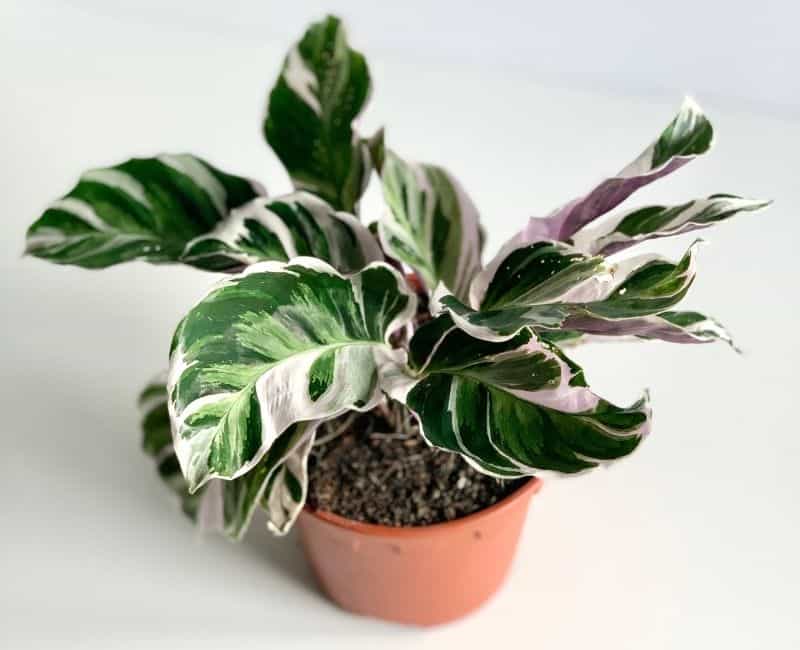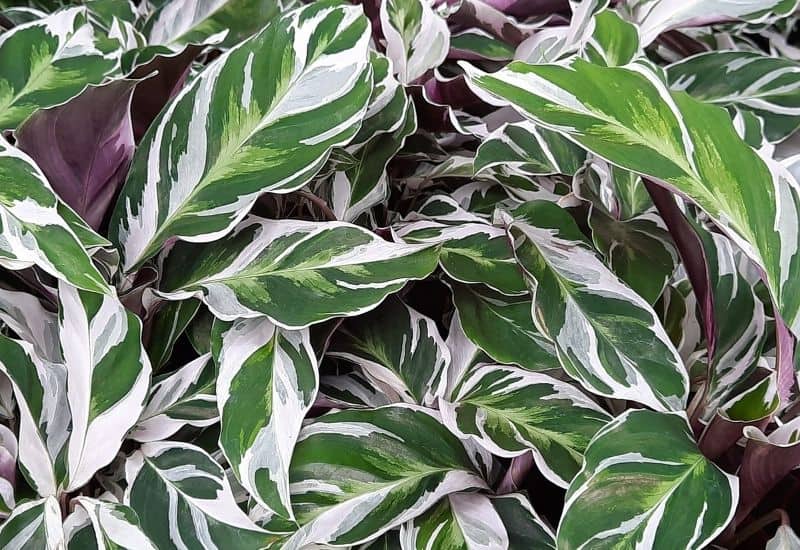The Calathea White Fusion is a distinct tropical plant that adds vibrant color to any home. This unique species is highly regarded because its leaves are more striking than many other plants’ flowers. They require proper nurturing to realize their true radiance, but the reward is well worth the effort.
Care Guide Overview
- How To Plant (when & where)
- How To Grow (staking, watering, fertilizing, humidity, mulching)
- How To Trim And Prune
- How To Pot And Repot
- How To Propagate (when & how)
- And Pests and Diseases, Toxicity
Characteristics
- Scientific name: Calathea lietzei
- Common names: Peacock Plant, Zebra Plant, Rattlesnake Plant
- Origin: Tropical Americas
- Indoor or Outdoor plant: Indoors only
- Height and Structure: 12 to 18 inches tall, 1 foot wide, it’s a compact and erect shrub that features clumps of slightly arched low leaves
- Flower Color: Rarely flowers when grown indoors, but small yellow flowers are possible
- Temperature: 60°F (16°C) to 80°F (27°C)
- Humidity: 75-85% humidity
How To Plant A Calathea White Fusion

This eye-catching plant is not particularly difficult to grow or care for. It does require precise environmental maintenance to thrive though. You should choose a spot indoors with partial sun and ample shade. The environment must remain consistent because Calatheas cannot handle wild shifts in temperature or humidity. Bathrooms and kitchens often provide appropriate moisture and warmth. It’s initial pot should be at least four inches, depending on the plant’s size. They require lightly packed soil and enough room to expand.
Light
These tropical plants are from the rainforest floor and therefore require filtered bright light. Direct light causes the distinctive leaf markings to fade and the leaves to curl. However, too much shade will prevent the vibrant colors that make the plant desirable from even developing. Place the pot near a window that faces east, west or north. These locations limit the amount of direct sunlight, but be sure it is not subject to temperature dips. If you prefer to place it in a sunnier spot of the home, use a sheer curtain to filter the light.
Soil
Packaged mixes that are recommended for African violets are best because they effectively absorb and retain moisture. If you prefer to fabricate your own mix, create one that is airy and lightweight. Combine one part parting soil, two parts peat moss and two parts perlite. Add pieces of orchid bark to keep the soil light and airy.
How To Grow A Calathea White Fusion

Watering
The Calathea White Fusion craves moisture. This is one of the main stumbling blocks for growers. Watering once a week or every other week is usually enough, but you must account for the climate in your home. Keep the plant consistently damp without making it soggy or waterlogged. Calatheas are susceptible to rootrot. Excessive moisture also creates a breeding ground for harmful bacteria and fungus. The plant must be in a raised pot with adequate drainage holes. Good drainage is vital to the plant’s health.
A good rule of thumb is to check the topsoil. If it is dry to a depth of 1 inch, water the plant. If the soil is moist to the touch, skip watering. The leaves also serve as an alert system. If they become crisp or brittle, the plant is probably too dry.
Fertilizing
Monthly application of nitrogen-rich liquid fertilizer is necessary during the growth period (Spring through Fall). The dose can be diluted by half. Liquid fertilizer is absorbed by the plant quicker. Check labels and select fertilizer intended for houseplants with dense foliage. Be wary of overfeeding the plant because excess nutrients can overwork the root system.
Humidity
This is a tropical plant that requires consistent humidity between 75-85%. Calatheas are not particularly resilient and will suffer during wild swings in humidity. If you live in a dryer climate or a colder one and run heaters all day, place a portable humidifier near the pot to maintain its ideal environment. A lower-tech solution is to sit the pot on a tray filled with pebbles. As the plant drains, the collected water will keep the plant moist without jeopardizing the roots.
Trimming and Pruning
Regular pruning is not necessary. Browned or extremely curled leaves can be cut off at the stem without harming the plant. Calatheas are efficient growers when healthy. New leaves will develop to replace the ones you excsied.
Pot And Repotting
Your Calathea requires repotting every year or two. It will signal when its time for a new home because the leaves will begin to wilt and roots will escape through the pot’s drainage holes.
Repotting is low risk and simple. Make sure the plant is healthy and well hydrated before attempting a move. A moist plant will be easier to remove from its pot. Prepare a new pot that is about 2 inches larger than the old one and fill it one-third of the way with soil. Gently remove the plant from its former pot and brush off old soil without disturbing the plant too much. Center the Calathea in its new pot and fill it in with fresh soil. Water the plant again, confirm it has adequate drainage and resume normal care.
Propagation
They are fairly easy to propagate through root division, which gives the new plant the best chance at survival.
Always propagate the Calathea in the Spring. This gives the roots a chance to take and an entire season to grow. Fill the new pot with pre-packaged soil or your home mix. Remove the donor plant from its pot by tipping it sideways and carefully brush the excess soil off of the root ball. Select a healthy-looking section from the ball that has a strong stem growing from it. Manually separate the section you chose as the new plant from the rest of the rootball. Use a sterilized knife if you prefer, but the roots can easily be separated by hand. Return the donor plant to its pot and plant the new plant in its own pot. Care for each plant normally
Pests And Diseases
Fungus gnats may invade your Calathea due to the high humidity it requires. Although they are a nuisance, they are not a threat to the plant’s survival. Insecticides may wipe out a widespread infestation. Coating the leaves with neem oil may deter the gnats, but is unnecessary.
Rootrot is a more insidious threat because it happens underground. Once it is apparent, it may be too late to save the plant. Excess moisture in the soil becomes a breeding ground for bacteria that will compromise the roots. Make sure you’re watering the plant correctly and providing adequate drainage.
Toxicity
Calatheas are completely non-toxic to humans and animals. However, as with any benign plant, ingestion can upset the digestive system.


